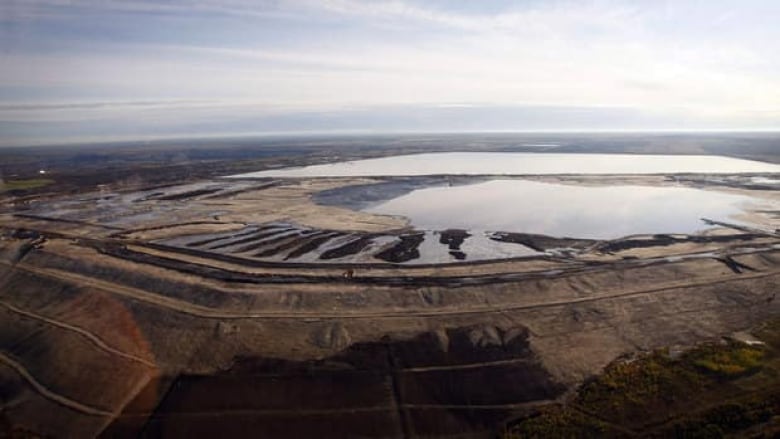Oilsands tailings cleanup far behind schedule
4 energy companies that were ordered to reduce waste miss regulator's targets

Alberta's energy industry has found that cleaning up oilsands tailings is much harder than it thought.
The province's energy regulator says all oilsands companies affected by tailings reduction rules missed what were supposed to be legally binding targets some by wide margins. All were given extra years to meet reductions that should have been done by now.
"It's tougher than they thought," Terry Abel of the Energy Resources Conservation Board said Tuesday. "It's tougher than we thought, too."
Tailings are the toxic byproducts of extracting bitumen, which is then upgraded into synthetic crude. Tailings are contained in large man-made lakes, and their impact on the environment has become a lightning rod for critics of the oilsands industry.
Reclaiming mine tailings has been one of the oilsandsindustry's major environmental challenges. Much of that waste material is composed of particles so fine they take years or even decades to settle out of tailings ponds. Without a way to hasten the process, oilsands tailings ponds have grown from 50 square kilometres in 2006 to 176 square kilometres today.
No companies met targets
In 2009, the board released regulations that were developed in consultation with industry and were designed to force energy companies to produce fewer tailings. By this year, operators were supposed to be removing at least half of those fine particles from their waste water and storing them so that they'd be firm enough to support a vehicle within a year.
But a recent report, which covers up to the end of 2012, found that none of the four licensed operators that so far come under the regulation was on track to meet that goal.
Suncor (TSX:SU), which was supposed to be removing 30 per cent of its particles, was capturing 8.5 per cent of them. Syncrude's (TSX:COS, TSX:SU, TSX:IMO) Mildred Lake project was removing 8.8 per cent of the 12 per cent required.
Shell's (NYSE:RDS) Muskeg River and Jackpine projects, on the hook for 23.5 and 15.5 per cent removals, respectively, were at 8.8 per cent and zero.
Five other oilsands licensees are either not yet producing or haven't been producing long enough to be required to report their removals.
Deadline extended
The energy conservation board has given most operators, including those who aren't yet reporting, until the end of 2015 to meet the 50 per cent guideline.
Some, such as Imperial Oil's (TSX:IMO) Kearl and Shell's Muskeg River projects, have until 2016. Canadian Natural Resouces Ltd.(TSX:CNQ) gets until 2017.
New, unproven technologies just aren't up to speed yet, said Abel.
Some operators, such as Suncor, hoped to dry thin layers of tailings in the sun but have found the weather unco-operative.
"(Our system) is still a relatively new technology in the early stages of development and commercialization," said spokeswoman Sneh Setal. "Since the first trial back in 2008, we've learned a great deal about the practical challenges of implementing (it) on a commercial scale."
Companies have promised to catch up by removing a higher percentage of particles in future years. But the board notes that the longer the wait, the harder the catch-up.
"Delaying the previously approved annual fines capture will make achieving the required cumulative fines capture in later years much more difficult," says its analysis of the plan from Canadian Natural Resources.
No sanctions for delay
No enforcement has been taken against any of the companies. Abel said operators have been working hard to meet the goals, collaborating on best practices and spending billions on tailings reductions.
"The big issue is that despite all of those efforts, they're running into problems making that work within those complex operations," Abel said. "We found that both they and ourselves were probably aggressive in setting those targets and believing we could get those performances as quickly as we were hoping."
Enforcement is a possibility if operators still aren't meeting their goals after the next report, expected in two years.
"We fully expect ... if they don't make progress on those operations, we'll take action against them in the future," said Abel.
That's not good enough, said Jennifer Grant of the Pembina Institute, a think tank focused on developing innovative sustainable energy solutions.
She points out that the board had already allowed operators some flexibility on deadlines, even though regulations were written with industry input.
"There's been a real shift in terms of that original thinking and what we're seeing today."
Grant suggested there are many new tailings technologies available and answers are probably nearer than industry suggests.
"I don't think addressing tailings is an insurmountable technical challenge. Operators could meet the tailings directive. It's really a question of whether they'll be forced to."












_(720p).jpg)


 OFFICIAL HD MUSIC VIDEO.jpg)
.jpg)



























































































